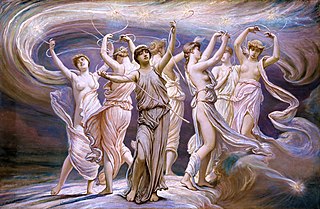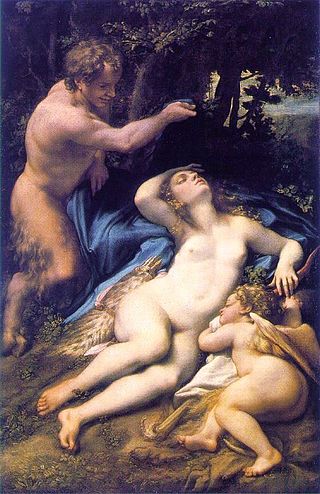Related Research Articles

Zeus is the sky and thunder god in ancient Greek religion and mythology, who rules as king of the gods on Mount Olympus. His name is cognate with the first syllable of his Roman equivalent Jupiter.

In ancient Greek religion and mythology, Helios is the god who personifies the Sun. His name is also Latinized as Helius, and he is often given the epithets Hyperion and Phaethon. Helios is often depicted in art with a radiant crown and driving a horse-drawn chariot through the sky. He was a guardian of oaths and also the god of sight. Though Helios was a relatively minor deity in Classical Greece, his worship grew more prominent in late antiquity thanks to his identification with several major solar divinities of the Roman period, particularly Apollo and Sol. The Roman Emperor Julian made Helios the central divinity of his short-lived revival of traditional Roman religious practices in the 4th century AD.

In Greek mythology, Phineus or Phineas, was a king of Salmydessus in Thrace and seer, who appears in accounts of the Argonauts' voyage. Some accounts make him a king in Paphlagonia or in Arcadia.
In Greek mythology, Oicles or Oecles, also Oicleus or Oecleus, was the father of the seer Amphiaraus. He accompanied Heracles on his campaign against Troy.
In Greek mythology, Cretheus may refer to the following characters:
In Greek mythology, Astydamea or Astydamia is a name attributed to several individuals:
In Greek mythology, the name Laodamia referred to:
In Greek mythology, the Heliadae or Heliadai were the seven sons of Helios and Rhodos and grandsons of Poseidon. They were brothers to Electryone.
In Greek mythology, Triopas or Triops was the name of several characters whose relations are unclear.
In Greek mythology, Tenages or Tenage was one of the Heliadae, a son of Rhodos and Helios. He was murdered by his brothers, Actis, Triopas, Macar and Candalus, who were envious of Tenages's skill at science being the superior out of the Heliadae.
In Greek mythology, Ochimus was the eldest of the Heliadae, sons of Helios and Rhodos.
In Greek mythology, Hyperion was one of the twelve Titan children of Gaia (Earth) and Uranus (Sky). With his sister, the Titaness Theia, Hyperion fathered Helios (Sun), Selene (Moon) and Eos (Dawn).

Aegina was a figure of Greek mythology, the nymph of the island that bears her name, Aegina, lying in the Saronic Gulf between Attica and the Peloponnesos. The archaic Temple of Aphaea, the "Invisible Goddess", on the island was later subsumed by the cult of Athena. Aphaia (Ἀφαῖα) may be read as an attribute of Aegina that provides an epithet, or as a doublet of the goddess.

In Greek mythology, Electra was one of the Pleiades, the seven daughters of Atlas and Pleione. She lived on the island of Samothrace. She had two sons, Dardanus and Iasion, by Zeus.
In Greek mythology, Macareus or Macar was one of the Heliadae, sons of Helios and Rhodos.

In Greek mythology, Antiope or Antiopa may refer to the following
In Greek mythology, Aeolus or Aiolos was the son of Hellen, the ruler of Aeolia, and the eponym of the Aeolians, one of the four main tribes of the Greeks. According to the mythographer Apollodorus, Aeolus was the father of seven sons: Cretheus, Sisyphus, Athamas, Salmoneus, Deion, Magnes, Perieres, and five daughters: Canace, Alcyone, Pisidice, Calyce, and Perimede. He was said to have killed his daughter Canace because she had committed incest with her brother Macareus. This Aeolus was sometimes confused with the Aeolus who was the ruler of the winds.
In Greek mythology, Bias, was one of the three kings of Argos when the kingdom was divided into three domains. The other kings were his brother Melampus and Anaxagoras. From Bias, they say, a river in Messenia was called.
In Greek mythology, Halia was a woman who according to Rhodian tradition became the sea-goddess Leucothea. She was a lover of the sea-god Poseidon to whom she bore seven children.
References
- Apollodorus, Apollodorus, The Library, with an English Translation by Sir James George Frazer, F.B.A., F.R.S. in 2 Volumes. Cambridge, Massachusetts, Harvard University Press; London, William Heinemann Ltd. 1921. Online version at the Perseus Digital Library.
- Diodorus Siculus, Diodorus Siculus: The Library of History. Translated by C. H. Oldfather. Twelve volumes. Loeb Classical Library. Cambridge, Massachusetts: Harvard University Press; London: William Heinemann, Ltd. 1989. 5.55.
- Fowler, R. L. (2000), Early Greek Mythography: Volume 1: Text and Introduction, Oxford University Press, 2000. ISBN 978-0198147404.
- Fowler, R. L. (2013), Early Greek Mythography: Volume 2: Commentary, Oxford University Press, 2013. ISBN 978-0198147411.
- Gantz, Timothy, Early Greek Myth: A Guide to Literary and Artistic Sources, Johns Hopkins University Press, 1996, Two volumes: ISBN 978-0-8018-5360-9 (Vol. 1), ISBN 978-0-8018-5362-3 (Vol. 2).
- Grimal, Pierre, The Dictionary of Classical Mythology, Wiley-Blackwell, 1996, ISBN 978-0-631-20102-1.
- Hard, Robin, The Routledge Handbook of Greek Mythology: Based on H.J. Rose's "Handbook of Greek Mythology", Psychology Press, 2004, ISBN 9780415186360.
- Homer; The Odyssey with an English Translation by A.T. Murray, PH.D. in two volumes. Cambridge, Massachusetts., Harvard University Press; London, William Heinemann, Ltd. 1919. Online version at the Perseus Digital Library.
- Larson, Jennifer, Greek Nymphs: Myth, Cult, Lore, Oxford University Press, 2001, ISBN 0-19-512294-1.
- Ovid, Metamorphoses , Brookes More. Boston. Cornhill Publishing Co. 1922. Online version at the Perseus Digital Library.
- Pindar, Odes, Diane Arnson Svarlien. 1990. Online version at the Perseus Digital Library.
- Smith, William; Dictionary of Greek and Roman Biography and Mythology , London (1873).
- Tzetzes, Chiliades , editor Gottlieb Kiessling, F.C.G. Vogel, 1826. (English translation, Books II–IV, by Gary Berkowitz. Internet Archive).